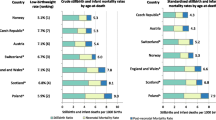Summary
Infant mortality rate is an important medical indicator and is often used for comparing countries with respect to welfare and public health. Among other factors, effective medical technology, better access to pre- and postnatal care for all socioeconomic groups and better nutrition have decreased infant mortality in Austria from about 200 deaths per 1000 live births at the beginning of the 20th century to about 5 deaths per 1000 live births at the end. In this study we present the trends in infant mortality, based on 1,654,519 individual birth records, in Austria since 1984. The infant mortality rate dropped rapidly from about 12 per 1000 live births in 1985 to 4.6 per 1000 live births during the last two years of our study (2001/02). Infant mortality rates stratified by cause of death show somewhat differing trends. In particular, the number of deaths due to peripartal problems decreased as the result of improvements in obstetrics and neonatology, but in 1995 a change in the definition of live birth led to a rise of about 20% in the stillbirth rate. At present, Austria has one of the lowest infant mortality rates of all European countries; however, between 1999 and 2002 the mortality rate has been fairly static. A further reduction in mortality clearly cannot be achieved by advances in medicine alone. It remains a challenge for health politicians, physicians and society at large to reduce the prevalence of well-known risk factors such as alcohol abuse, heavy overweight and smoking during pregnancy.
Zusammenfassung
Säuglingssterblichkeit ist ein wichtiger medizinischer Indikator und erlaubt Vergleiche einzelner Länder in Bezug auf Sozialwesen und öffentliche Gesundheit. Einflussfaktoren wie effektive Medizintechnologie, besserer Zugang zu prä- und postnataler Schwangerenbetreuung für alle sozioökonomischen Gruppen, als auch bessere Ernährung senkten die Säuglingssterblichkeit von circa 200 Todesfälle zu Beginn auf circa 5 Todesfälle je 1000 Lebendgeborenen am Ende des 20. Jahrhunderts in Österreich. In dieser Arbeit zeigen wir den Zeitverlauf der Säuglingssterblichkeit in Österreich seit 1984 basierend auf 1.654.519 Geburtsblättern. Die Säuglingssterblichkeit fiel drastisch von 12 je 1000 Lebendgeburten im Jahre 1985 auf etwa 4,6 je 1000 Lebendgeburten in den letzten zwei Jahren des Studienzeitraumes (2001/02). Betrachtet man die Todesursachen im Einzelnen, so ergeben sich etwas unterschiedliche Kurvenverläufe. Im Besonderen verringerte sich die Anzahl der peripartalen Todesfälle auf Grund von Fortschritten in Geburtshilfe und Neonatalogie. Eine Änderung der Definition von Lebendgeburten führte zu einem scheinbaren Anstieg der Totgeburtenrate im Jahr 1995 um etwa 20 %. Österreich gehört derzeit zur Gruppe der europäischen Länder mit der geringsten Säuglingssterblichkeit. In den letzten Jahren stagniert diese allerdings. Ein weiterer Rückgang kann offenbar nicht nur durch Fortschritte im Bereich der Medizin erfolgen. Gesundheitspolitiker, die Gesellschaft und die Ärzte sind gefordert, um die Prävalenz von bekannten Risikofaktoren wie Alkoholabusus, starkem Übergewicht und Rauchen während der Schwangerschaft zu reduzieren.
Similar content being viewed by others
Author information
Authors and Affiliations
Corresponding author
Rights and permissions
About this article
Cite this article
Waldhör, T., Vutuc, C., Haidinger, G. et al. Trends in infant mortality in Austria between 1984 and 2002. Wien Klin Wochenschr 117, 548–553 (2005). https://doi.org/10.1007/s00508-005-0401-4
Received:
Accepted:
Issue Date:
DOI: https://doi.org/10.1007/s00508-005-0401-4




